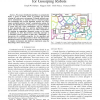2537 search results - page 428 / 508 » How to draw a group |
TEI
2010
ACM
13 years 10 months ago
2010
ACM
Many installations research efforts today explore how to engage participants with embedded digital content and applications in interactive environments. Yet the interactive design...
BIOINFORMATICS
2010
13 years 10 months ago
2010
Phylogenetic trees are widely used to display estimates of how groups of species evolved. Each phylogenetic tree can be seen as a collection of clusters, subgroups of the species ...
BC
2007
13 years 10 months ago
2007
We consider the issue of how to read out the information from nonstationary spike train ensembles. Based on the theory of censored data in statistics, we propose a ‘censored’ m...
CN
2010
13 years 10 months ago
2010
The natural world is enormous, dynamic, incredibly diverse, and highly complex. Despite the inherent challenges of surviving in such a world, biological organisms evolve, self-org...
CORR
2010
Springer
13 years 10 months ago
2010
Springer
We propose distributed algorithms to automatically deploy a group of mobile robots to partition and provide coverage of a non-convex environment. To handle arbitrary nonconvex envi...

